On the first day of the course Beth introduced us to the concept of ‘Commons’. According to De Angelis’ explanation of the word, I understood the lyrics to represent the interaction between people and places, the activities and effects of people in a community setting.
After discussion our group chose Culture Commons and targeted the Gallery. The Scottish National Gallery was the first place that came to mind in Scotland, and Beth also recommended Ingleby Gallery and Fruit Market Gallery, and the next day our group went to The Scottish National Gallery.
The Scottish National Gallery is the oldest of Scotland’s galleries and houses one of the richest and most valuable collections of European painting and sculpture in Scotland, covering all genres from the Renaissance to Post-Impressionism, and is one of the finest galleries of its size in the world. Such a long-established and renowned gallery has been perfected in every way, and in order to make it even better, I focused mainly on Limitation during my visit.
At the entrance to the gallery, visitors can see the layout and introduction of the venue. One of the things that attracted me was an app called Smartify, which visitors can download on their own and use to scan the paintings to see the relevant presentations during their visit to the gallery. However, this app is not very popular and has not received a high level of promotion. The Scottish National Gallery’s website does not have a description of the app, and it would have been better if it had been made available in advance, so that people could download it before they visit, view the paintings they are interested in, and then see them in person.
The second limitation is the language, as the official website of The Scottish National Gallery, the descriptions of the works in the venue and the explanation of the works in Smartify are all in one language – English. The Scottish National Gallery is also a well-known tourist attraction in Edinburgh and is visited by a large number of foreign visitors, but the brochures distributed at the gates are also in a single language, English, which ignores the needs of international visitors.
A third limitation is that there is no lift in The Scottish National Gallery and sections 14-18 are on the first floor, which makes the experience less accessible to disabled visitors.
A final limitation is the lack of clarity of information on the website, which can be a disincentive to visitors. For example, the division between entry and pavilion. As a result, many people went to the Royal Scottish Academy and then had to consult with the doorman for a long time before they could tell the difference between the different pavilions.
I found some specific data about The Scottish National Gallery, but I did not have any data about Ingleby Gallery and Fruit Market Gallery. I found some specific data on The Scottish National Gallery, but not on Ingleby Gallery and Fruit Market Gallery.
I started by searching Visitor figures for UK museums And galleries. According to a report on monthly visits to museums and galleries on the GOV.UK website, 50% of people aged 16 and over visited a museum or gallery in the past year between 2018 and 2019 51% of white people visited a museum or gallery, compared to 33% of black people and 43% of Asian people.

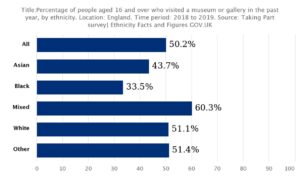
From this, It can be concluded that in each ethnic group, the percentage of people who had visited a museum or gallery remained broadly consistent.
According to the chart Number of visits to the Scottish National Gallery in the United Kingdom (UK) from 2011 to 2012 ,we can see a sharp decrease in the number of visitors in 2020 and 2021. Again, this shows the impact of the epidemic on the number of visitors to the gallery, and also shows that foreign visitors are a very important group of visitors to the Scottish National Gallery.
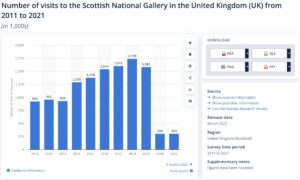
Sources from:
https://www.statista.com/statistics/586835/scottish-national-gallery-visitor-numbers-united-kingdom-uk/
I have since found the information in the National Galleries of Scotland’s annual report. Visitor capacity has increased over the past year and by March 2022 visitor numbers are starting to show clear signs of recovery .Web traffic and engagement through social media continues to rise year on year, positively impacting numbers through engagement with our digital content.Digitisation of the collection is limited by the fact that only a small number of staff are able to work on site and have access to the objects. So with regard to performance indicators, the National Galleries of Scotland has been revised in line with six priorities and further work has been undertaken for 2022-2023.
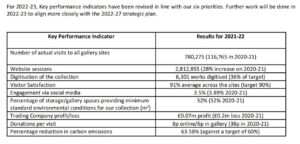
After that, in terms of collections, I compared the number of items in the 2022 collection with the number of items in the 2020 collection.
The total number of items in the 2022 collection is over 20,000 more compared to two years ago.
Reading their report we can see that the majority of collections acquired have come from donations and the NGS Trust, as well as generous gifts and bequests. This has enabled the collection to continue to grow steadily.
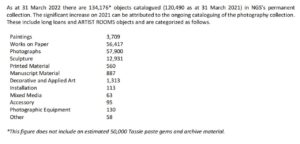
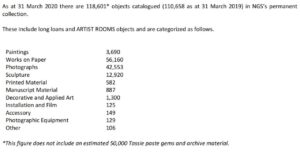
Sources from :
National Galleries of Scotland
Trustees’ Annual Report and Financial Statements for the year ended 31 March 2022


s2444627
22nd November 2022 — 2:09 pm
The blogger has published a lot of data analysis, which is very intuitive stuff. And I was part of the same group as the blogger and we were able to look at our survey from different perspectives and come to different conclusions. One thing that I found interesting was that the blogger focused more on the exhibition facilities in the gallery and suggested some strengths and areas for improvement. This is something I had not thought of before.
s2457669
29th November 2022 — 12:19 pm
i like the idea you have set out exploring the gallery- how we use it and how it fits into ideas around the commons. you mention you ‘targeted’ the gallery, maybe seeing straight away a need to carry out this research and seek ways of making the gallery experience ‘better’ through ways of the commons. it was really interesting hearing about galleries nearest to us, both public and private, learning about who uses galleries the most or least in relation to the rest of the UK. i wonder how accessible information like this is and what the goals are for summarising figures like this is.
s2248556
30th November 2022 — 1:45 pm
It is not difficult to see the books and materials consulted in the author’s article, which is very important for conducting research, including the types of visitors, ages, etc. of different exhibition halls. I have also experienced the Smartify software, and there are indeed many problems. The author listed and improved them respectively, and I think it is great.
s2313334
6th December 2022 — 8:18 pm
The blogger has written a tonne of insightful articles about data analysis. Additionally, because I was in the same group as the blogger, we were able to approach our survey from various angles and get distinct results. The blogger’s emphasis on the gallery’s exhibition spaces and his suggestions for strengths and improvement struck me as particularly noteworthy. I never considered doing this before.